
morey - weber : surf contests, 1966
| home | catalogue | history | references | appendix |
 |
surfresearch.com.au
morey - weber : surf contests, 1966 |
| Morey, Tom: Surfer Tips Number - How to compete in 1966. | Weber, Dewey: The Makaha Contest is the Worst! |
Alternatively,
his
second innovation, "timed" surfing, had already been used in
Morey's Noseriding
Contest at Ventura in July 1965.
In this contest
the rider was timed by stopwatch while on the front 25% of the
board"
(designated by a coloured deck patch or band), with awards for
the longest
individual ride and the accumulated time over a maximum 14
waves.
In 1966, Morey
substantially
broadened the criteria-"surfers with the most accumulated time
standing
up on the board for wave opportunities will be the winners."
Essentially,
at its
core, this was a paddling contest- the surfer who rode the
longest distance
and was the fastest to paddle back to the take-off zone to
catch another
wave would accumulate the most points.
Incredibly,
from
a 21st century perspective, this approach, without any
consideration of
surfing performance, was regressive.
More
immediately,
it was in marked contrast to the intensive analysis of
performance surfing
currently explored by Australian competitors, the elite of
whom were soon
to arrive in California for the 1966 World Contest.
Perhaps bouyed by the enthusiasm and wide exposure of the earlier noseriding contest, it appears that no American competitor recognised the reactionary element of this format, put into use at the contest and attended. XXXXXXXXXXXX
Dewey Weber's article on Makaha voices many of the ongoing concerns of competition surfers about the structure and format of surfing contests at this time.
South
Africa
Ron Perrott's
article
on South Africa initiated the first major controversy for the
Surfer
staff.
In the body of
the
article, Perrott appeared somewhat apologetic for the policy
of Apartide:
"Half believing
some of the more distorted 'facts' on South Africa prevalent
in Australia,
I was completely unprepared for the friendliness and courtesy
received
from all sections of the community - whether Indian, Bantu or
white South
African." - page 65.
However, one
photograph
and its caption, "Durban's beaches are segregated so this
native youngster
can't join these three surfers ... for a little fun in the
surf" (possibly
added by the editor), produced a unprecedented response.
In susbequent
editions,
a number of readers suggested that rascism was an unsuitable
topic for
a surfing magazine.
Twelve months
later,
this controversy would appear relatively minor, compared to
the response
to We're Tops Now, by Australian, John Witzig.
The article was
originally published, with a far less confronting title, as
Nat
vs. Nuuhiwa ... How Do We Compare?
Surfing
World
Volume
8 Number 4, pages 10 to 13. January 1967.
In 1985, professional surfers buoycotted contests in South Africa in protest at that country's, now repealed, racial legislation.
Inca Surfer
The ceramic
figure,
illustrated in the Pipeline column on page 75, has
never been referenced
in any of the subsequent literatue on the origns of surf
riding.
Articles
Rusty Miller
Interview, pages 25-31.
John Pennings:
Big
Drop at Little Avalon, pages 33-35.
Dewey Weber: The
Makaha Contest is the Worst!, pages 57-61.
USSA
1966 Ratings, pages 40-41.
Bill Cleary: Honolulu
Bay, pages 42-49.
Richard
Safaday:
Some
Like It Smooth, pages 54-57.
Extolling the
virtues
of a "smooth style", the article was perhaps a response to the
"aggressive"
style, as said to be promoted by Australian surfers.
Ron Perrott: "Crocodiles,"
Zulus and Surf Suid Afrika, pages 58-65.
Pipeline,
pages 75.
Griffin and
Stoner:
The
Banzia Pipeline, pages 83-90.
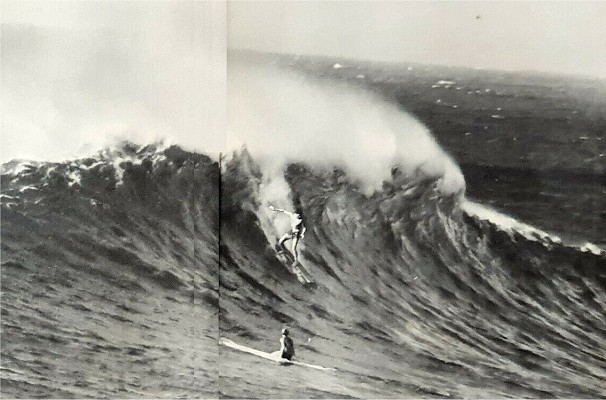 Rusty Miller and windy Sunset
Beach.
|
Page 30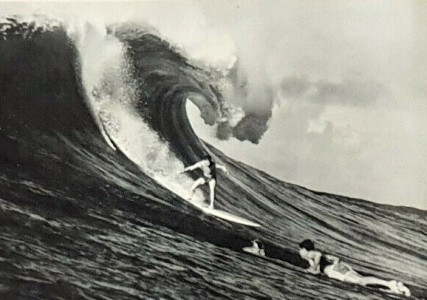 Rusty Miller and Mickey Dora,
Sunset Beach.
|
Page 31 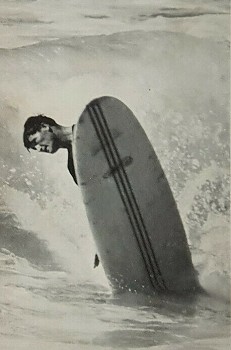 Rusty Miller, Makaha.
|
When Dewey
Weber
and the famous Makaha surf first met, it was obvious they
were meant for
each other.
With hot
sectIons
running into flat shoulders, Makaha was ideal for Dewey's
style.
A half dozen
quick steps and he was on the nose blasting through the
curl, and then
with incredible quickness, he was on the tail block jamming
a radical cutback.
Dewey's
reputation
as a hotdogger was already tops when the Makaha
International Contest was
established.
In 1956,
Dewey
first entered as a junior but ran into the kind of bad luck
that frequently
plagues Californians in the Makaha contest. Dewey had caught
his allotted
six waves and the consensus of surfers on the beach was that
the little
hotdogger from the South Bay had won hands down.
His flag
went
up on the beach- indicating that the allotted rides had been
completed-
so Dewey caught the next wave into shore. As he walked up to
the judge's
stand, he was as stunned as anyone to learn that he had BEEN
DISQUALIFIED
FOR RIDING ONE TOO MANY WAVES- the one he took into shore!
But
undaunted,
Dewey, like many top California surfers, returned several
times to the
Makaha contest.
Last year
Dewey
battled his way through the semi-finals into the finals
where he turned
on his famous hot-dogging style.
The
all-Hawaiian
judges picked him eighth.
Dewey has
much
better luck in non-Hawaiian contests and last year finished
fourth in the
United States Surfing Association competition.
Dewey's been
a top performer in major competition for ten years -a record
few other
surfers can match.
So Dewey's
pretty
well qualified to say:
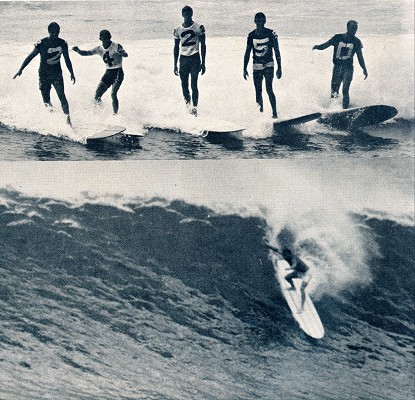
Page 37
Yes, from the viewpoint of the guy out there in the water with the numbered T-shirt, the Makaha contest is the worst in surfing competition: a glaring example why surfing doesn't have the acknowledgment and recognition given other competitive sports on the international sports scene.
The contest
is
fine as a crowd event because that's exactly what it is.
This was
underscored
by a Honolulu newspaper, The Advertiser, that pointed out
during the last
contest that heat winners were the ones, in most cases, who
impressed the
spectators.
Little
mention
was given to the ability or performance shown by the
competitors and, in
fact, the newspaper article focused on incidents that were
"humorous for
the spectators."
This typical
news coverage underscores that crowd-pleasing ability
overshadows wave
ability and performance.
Twenty-four
competitors
jammed into the 30-minute heats pretty well assures the
spectators of humorous
incidents.
Among the
top-notch
competitors who year after year show up at the contest,
there's general
agreement that the regulation rules and scoring methods are
as outmoded
as the old redwood plank of bygone surfing days.
The Makaha
contest
is famous for its judging prejudices and yet year after year
the big name
surfers, and a lot of little name surfers, flock to Hawaii
to sign up for
a competitive meet that is actually detrimental to the
development of surfing.
It's
somewhat
puzzling, but I feel the contest is supported by surfers
strictly out of
enthusiasm for competition as well as the honor, fame and
now fortune that
goes to the winner.
Page 38
Page 39
Take my
case:
I competed last year because I really love surfing
competition and, too,
I felt that by competing I'm more qualified to form opinions
about the
contest and surfing as a whole.
As a
competitor,
Makaha's shortcomings became quite clear, and yet I was able
to see the
great potential of this contest as a truly international
meet.
Certainly I
would
be willing to give my full support if Makaha officials and
the competitors
would get together and- with the help of the United States
Surfing Association
- take advantage of the "opportunity to improve."
But with the
Hawaiian attitude, the chances of this are slim.
Surfing's
changed
an awful lot in the last ten years, and yet the regulations
governing last
year's Makaha championships differed only slightly from
those used in 1956
- the first time I entered the contest.
Some of the
obviously
out-moded regulations have been dropped, but plenty of
outdated principles
and even a few ambiguous rules have been added.
The
regulations
no longer limit the number of waves a contestant may ride,
but the mass
of contestants (last year, 550 signed up) make it virtually
impossible
for anyone contestant to ride "too many waves."
Discontinued,
too,
is the use of distance markers.
However,
distance
is still a key factor in accumulating points from the
judges.
Makaha's
regulauons
were set up thirteen years ago on the premise that big-wave
riding was
the only true test of surfing ability. Rules and scoring
system accommodated
the then prevalent method of scoring surfing contests on
wave size and
points were accumulated on the takeoff and ability to stay
trim with the
emphasis on the distance of the ride.
And so for
thirteen
years the emphasis has stayed on big-wave riding - giving
points for the
height of the wave and the distance of the ride.
Yet most of
the
Makaha competition has been run in small surf, but the
judges' system still
stresses the big wave, and no rules have been set up to
accommodate small
surf experts.
In order to
obtain
points, according to the Makaha rules, a surfer must stay in
the critical
part of the wave (the hook next to the breaking section) at
all times.
This may be
a
logical way to ride a big wave, but it can't be applied to
surf under eight
feet.
In small.
surf
keeping the surfer in the most critical part of the wave
limits his opportunity
to perform.
But any
Makaha
competitor who takes off, trims, limits his maneuvers and
rides all the
way to shore, racks up more points than the surfer who
leaves the most
critical part of the wave by cutting back, climbing,
dropping, even though
this surfer throughout the ride returns again and again to
the critical
portion of the wave.
Wally Froseith clarified, I think, Makaha's judging criteria when he said, "A surfer who catches a wave outside and rides it all the way to the shore definitely has more opportunity to perform and will, on the average get more points."
Wally's
statement
underscores the emphasis placed on distance and also points
out Makaha's
ambiguous judging premises. Officials have never explained,
as far as I
know, how the judges determine if "opportunity to perform"
is present.
And if it
is,
how do the judges determine if the surfer takes full
advantage of this
opportunity to perform?
"MAKAHA BASED ON LUCK"
This is
especially
unfair to surfers, considering there's usually a dozen, even
two dozen,
surfers in the water in each heat.
If a surfer
is
lucky enough to catch the largest wave in a 30-minute heat
and have it
all to himself - ride it all the way to the beach - his
score should not
be based on luck, but rather on his ability in taking
advantage of "the
opportunity to perform."
That is, how
well did the surfer execute his ability on the wave?
Just about
all
the contestants agree, as far as I know, Makaha's emphasis
on height of
wave ridden and the distance of the ride overshadows
contestants' performance
on the wave.
In my
opinion,
a true international champion doesn't purposely place limits
on his ability
to perform.
The
champion,
for my money, is a surfer who displays not only endurance,
judgment and
balance, but also is outstanding in the water.
He's the
surfer
who gets the most out of each and every wave by pushing his
ability to
perform to the fullest.
And so since
the rules at Makaha limit the ability to perform, I don't
feel they produce
a champion in the sporting sense of the
word.
There was
something
new in last year's contest: points were deducted for
unsportsmanlike conduct.
Now no one
can
argue that good sportsmanship has a place in every
competitive sport.
However, the
way this rule was applied at many contestants didn't even
know about it
until after completion of the competitive events.
And it's
still
not clear to me what guide lines were used by the judges in
determining,
in their opinion, what actually was a deliberate lack of
sportsmanship
in the water.
The judges
didn't
define what they meant by unsportsmanlike conduct, but they
still deducted
the points.
In many
cases,
surfers lost points when, attempting to get the most out of
the wave, they
accidentally bumped the rail of another competitor's board.
In the
judges'
opinion, this often was construed as a deliberate act of
unsportsmanlike
conduct and may explain why many surfers from the mainland
and Hawaii were
knocked out early in the contest, even though they showed
excellent ability
to perform- and weren't even aware of any deliberate
unsportsmanlike acts.
Surfing is
progressing,
I think, to the point where it can obtain the recognition
given other competitive
sports.
However,
even
though I'm one of surfing's greatest boosters, I can't
honestly .say that
the sport deserves that recognition now. Every competitive
sport, whether
a team or individual, has a governing body setting forth
uniform rules
and regulations that apply to meets.
And surfing
doesn't
have this.
Even though
the
sport does have such a body - the United States Surfing
Association.
The USSA
has,
and is continuing to make, a needed attempt to standardize
rules and regulations
used in surfing meets, but lack of support, principally by
the surfing
public and contest promoters, has blocked this.
And so it's
impossible
for the USSA to enforce uniform rules at every surfing meet,
whether in
California, Hawaii or New York.
A surfing
competitor
can surf in one contest under one set of rules and then
enter a contest
in another city or state where a completely different set of
rules apply.
This
condition,
I think, is uncommon in any other sport - yet it happens
every day in surfing.
I believe
every
competing surfer wants surfing to be accepted as a
competitive sport.
I know I do,
but we must remember that to reach that degree of
sophistication, surfers
must strive for the quantities and qualities found in other
sports.
We must
learn
to profit from past mistakes, the use of outdated
regulations, poor scoring
systems.
Surfers must
take action to eliminate contests run under rules that
hinder favorable
acceptance of the sport by the general public.
Above all,
we
must keep in mind that blame for badly-run contests such as
Makaha should
not entirely be put upon shoulders of a small group of
officials or sponsors.
We, the
competitors,
share this blame because we let it happen, we were a part of
it - and a
lot of us probably will be part of it again unless it's
changed by us.
USSA 1966 RATINGS
The 1966
ratings
of the United States Surfing Association mark a milestone in
surfing competition
that probably means the end of contests dominated by just a
few top surfers.
For the
first
time, the USSA has segregated surfers into three categories-
AAA, AA and
A.
This is
similar
to international ski ratings and means that the top
competitors will battle
each other in contests, while lesser-rated surfers will
compete in separate
AA and A heats.
USSA
Competition
Chairman Hoppy Swarts pointed out that not all contests on
the circuit
this year will be segregated.
He said
there
will be a number of open contests where the three categories
will compete
together.
That is, the
AAA, AA and A surfers will be in the same heats.
But details
of
these open contests are still being worked out, Swarts said,
and will be
released later.
Under this
system,
surfers can move up - and also down - the competition
ladder.
For example,
Single A surfers can, by racking up contest points, move up
to AA and even
AAA ratings.
The same
holds
true for AA surfers.
Triple A
surfers
will, of course, have to defend their top position - or drop
back into
the AA or Single A division.
The placings
were computed on how surfers fared in contests in 1964 and
1965.
A two-year
spread
was used so that a top surfer would not lose his position
after merely
one bad contest year.
Here's the
list
for men, women and juniors.
Unfortunately,
space
doesn't permit running the Single A competitors in each
division
as the list runs into hundreds of names.
| MEN'S
TRIPLE
A
1. Rusty Miller 2. Skip Frye 3. Donald Takayama 4. Dewey Weber S. Corky Carroll 6. Rich Chew 7. Joey Cabell 8. Phil Edwards |
9. Steve Bigler 10. Mark Martinson 11. Robert August 12. Mike Doyle 13. Robert Kooken 14. John Peck 1 S. Bobby Patterson 16. Mickey Munoz |
WOMEN'S
TRIPLE
A
1. Joyce Hoffman 2. Joey Hamasaki 3. Nancy Nelson 4. Josette Lagardere 5. Dee Dee Arevalos 6. Margo Scotton 7. Linda Benson 8. Gail Yarbrough (Williams) |
Page 41
| JUNIORS
TRIPLE
A
1. David Nuuhiwa 2. Denny Tompkins 3. Pete Johnson 4. Herb Torrens 5. Mike Stevenson 6. Alf Laws 7. Herbie Fletcher 8. Dale Struble 9. Dru Harrison 10. Dickie Moon 11. Mike Purpus 12.. Bill Gray 13. Greg Tucker 14. Jim Irons 15. Bill Hamilton 16. Steve Schlickenmeyer |
OPEN
TANDEM
1. Mike Doyle 2. Pete Peterson 3. Don Hansen 4. Bob Moore 5. Jack Iverson 6. Mickey Munoz 7. Steve Boehne 8. Hobie Alter 9. Jim Graham 10. Joe Metzger 11. Rusty Miller 12. Corky Carroll 13. Nick Carollo 14. Sam Harwood |
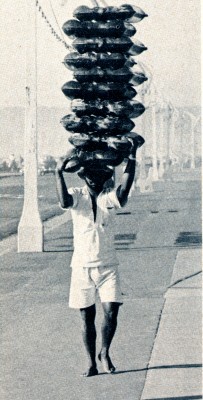 |
Left:
Page 61 Durban's not always crowded, however, and during April before the July crowds, it frequently looks like this as a native carrying stacked surf riders strolls down an almost deserted main street on the strand. Right:
Durban's beaches are segregated so this native youngster can't join these three surfers strolling along Dairy Beach near the West Street Groyne for a little fun in the surf. |
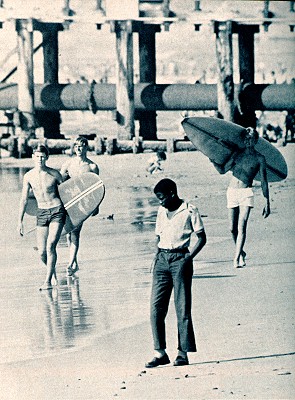 |
Half
believing
some of the more distorted "facts" on South Africa prevalent
in Australia,
I was completely unprepared for the friendliness and
courtesy received
from all sections of the community - whether Indian, Bantu
or white South
African.
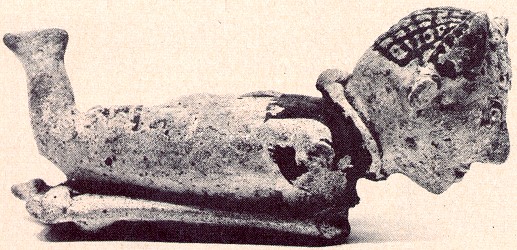
Page 76
LOST
HOOD ORNAMENT DEPT.
Honolulu
police
are trying extra hard to crack the case of the missing
automobile hood
ornament.
Why?
Because the
11-inch,
5-pound statuette was taken from the car of Duke Kahanamoku.
The ornament
depicts Duke riding a surf- board.
A
hundred-dollar
reward, with no questions asked, has been posted for its
return.
The ornament
was torn from the hood of Duke's Lincoln Continental while
the car was
parked for just a few moments near the Edgewater Hotel at
Waikiki Beach.
The Duke,
who
had loaned his car to a friend, was in New York at the time
to appear on
the Ed Sullivan show and attend the opening of the Swimming
Hall of Fame
in Florida.
It's
especially
tragic because the ornament was hand-carved 30 years ago by
an artist now
dead.
There is no
existing
mold.
Commented
the
Duke: "You know, I place great sentimental value on that
statue, perhaps
more than on many of my other awards." Considering all the
baubles, trophies
and medals that Duke picked up as the Island's greatest
surfer, swimmer
and Olympic Champion - that's quite a statement.
The Duke
added:
"I'm sure no surfer or Island fellow took it, because no one
would do such
a thing."
 |
Volume 7 Number 2 May 1966. Cover:
Copy
courtesy of
the Graham Sorensen Collection.
Rusty Miller and windy Sunset
Beach.
Page 27. |
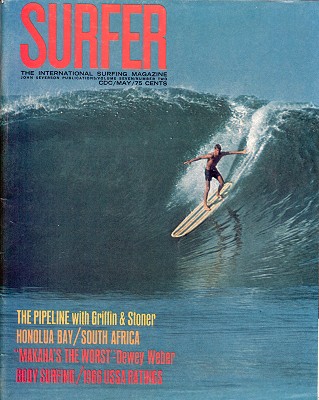 |

| home | catalogue | history | references | appendix |